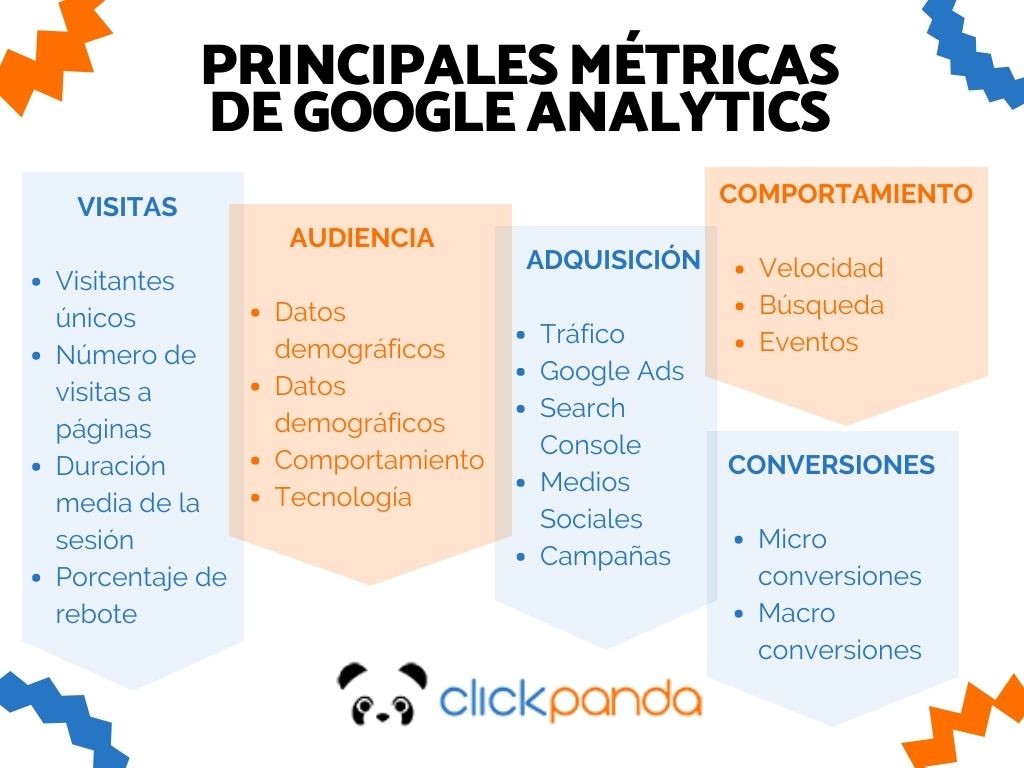Table of Contents
Google Analytics is the main tool you should use if you don't want to lose all the effort you invest in your digital marketing strategies, SEO and SEM (Search Engine Marketing).
This valuable tool is integrated with other services offered by Google, such as Search Console y AdSensewhich, together with Google Ads allows website owners or administrators to know everything that is happening on the website and how visitors interact with the site. In this article we will tell you about the main features.
What is Google Analytics?
Google Analytics is a powerful online analytics and tracking tool developed by Google, designed to provide website owners and marketers with detailed insight into the performance of their online platforms. This service provides valuable information about web traffic, user behavior and effectiveness of implemented digital marketing strategies.
By using Google Analytics, users can collect essential data such as the number of visitors, session duration, most visited pages, traffic sources, and other relevant metrics. In addition, the tool provides advanced analytics to understand user behavior on the site, identify trends, evaluate the impact of advertising campaigns, and optimize the user experience.
The Google Analytics service is free and has a user-friendly interface and great capacity to process data. There is also a paid version called Google Analytics 360, this is recommended for large companies that have a high number of traffic on their website. These two options have very similar functions, so if your website does not have too much traffic you can use the free version to improve the performance of your website and your business.
Google Analytics Key Metrics
Visit
 Every time someone enters your website and browses it, Google Analytics register a visit. Remember to keep in mind that even if you see a high number of visits in your metrics, this does not indicate that your website is being a success. From this data you can have information that will allow you to know how are the results of the marketing strategy you are implementing. In visits you must take into account the following metrics:
Every time someone enters your website and browses it, Google Analytics register a visit. Remember to keep in mind that even if you see a high number of visits in your metrics, this does not indicate that your website is being a success. From this data you can have information that will allow you to know how are the results of the marketing strategy you are implementing. In visits you must take into account the following metrics:
- Unique visitors: It gives you information about the number of different visitors entering your website. You will be able to see a graph showing the ratio of new visitors to the number of returning visitors.
- Number of page views: It indicates the number of page views, this will help you to know the interest that users have for the content of your website, so the more pages viewed per visit, the more interest the user has.
- Average session duration: This metric provides you with information about the time each user spends browsing your website. This data will let you know if the user finds your content useful; the longer the duration, the higher the quality of your page. Likewise, Google will take it into account since it is one of the most valued parameters by this search engine.
- Rebound percentage: Refers to users who enter your site and leave without generating an interaction with the web. Specialists in the subject conclude that the main pages, being the starting point, have a lower bounce rate than other specific contents.
This metric allows you to evaluate the quality of your content and the relevance between them, as well as the navigation behavior within your site.
Audience
It is very important that you know who your audience is so you can focus on your target audience. Google Analytics will be your best tool, allowing you to know what are the characteristics of the users who visit you.
In Audience you must take into account the following metrics:
- Demographic data: It provides the necessary information for you to segment your audience into gender and age categories, this allows you to target your content to the profile of your visitors.
- Geographic information: This metric will allow you to segment your audience according to the language they use and their location.
- Behavior: With this information you will be able to compare new and returning visitors, frequency, consistency and interaction.
- Technology: This metric allows you to know the operating system, browsers and types of devices from which the user enters your website.
Acquisition
If you want to know how users arrive at your website, you should analyze the acquisition reports, with these you will be able to know if users arrive directly or through a search engine and also the route by which they have entered your website.
The traffic to your site is grouped into several channels, these are:
- Organic search: The one that is performed by search engines.
- Direct: These are the users who type the domain directly.
- Referral: Users arrive through referral domains.
- Paid search: Through marketing campaigns.
- Social NetworkingUsers come to your website through social networks.
- AffiliatesDisplay (marketing campaigns).
In Acquisition you must take into account the following metrics:
- Traffic: It gives you an overview of the traffic coming through the main channels.
- Google Ads: You must have linked the account of Google Ads with Google Analytics to receive information about the campaigns you are developing and their performance.
- Search Console: You must link both accounts, in this way you will be able to control the data you receive in Search Console from Google Analytics.
- Social MediaThis type of report is useful to know the visits that come to your website from social networks.
- Campaigns: It provides information on any marketing action you are performing, such as: Google Ads, Facebook Ads or Instagram Ads.
Behavior
Behavioral reports will help you understand how users interact with your website.
In Behavior you should take into account the following metrics:
- Site speed: It shows the page loading speed. With this information you will be able to improve the content strategy to retain and retain the user.
- Site search: You can use it especially if you have an online store since you will be able to evaluate the searches that are made through the internal search engine of your website.
- Events: If you want to receive information about events, you have to create this option first.
Conversions
These are the reports of Google Analytics The most important, as they will provide you with the indicators to know if the marketing strategies are working.
- Micro conversions: These are the ones you use in a conversion funnel, such as a click, watching a video or downloading an e-book. Micro conversions help the user to make a macro conversion. For example, in a landing page we have a banner with a call to action of a product (micro), the user clicks on the button, it takes him to the product where he finally decides to buy it (macro).
- Macro conversions: are given when a user makes a complete purchase, a transaction.
In order for these reports to show you conversions, you must define your objectives beforehand in Google Analytics.
By offering a detailed overview of key metrics, this tool becomes an efficient guide in strategic decision making, allowing precise adjustments and continuous improvements in user experience. From understanding visitor behavior to assessing the impact of marketing campaigns, Google Analytics is a fundamental ally in web optimization.







